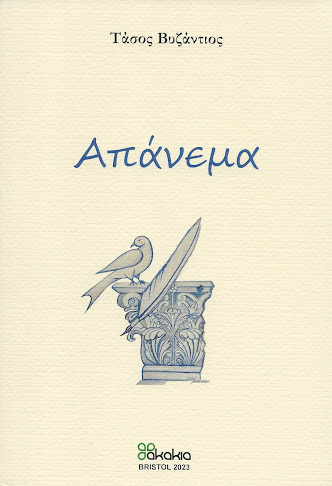skip to main |
skip to sidebar
The Bat Poet: Poetry as Echolocation
This is the unlikely
title of the inaugural lecture delivered in the Examination Schools, Oxford on
20 November 2023 by the recently elected Professor of Poetry, Alicia Stallings:
an American poet who has lived in Athens for the last 25 years. She is married
to the Al Jazeera journalist, John Psaropoulos.
 |
Note the bat necklace |
The lecture
made a dramatic start: the first slide was projected upside down. There was a
bat among us.
The
Professor, who is more commonly known by her initials as AE Stallings, started
by recounting an experience she had when she was about five years old. She was
taken on a visit to the vast Mammoth Cave, Kentucky, home to six species of
bat, which was the start of her fascination with bats; her imagination fired
with notions such as ‘living upside down’ and ‘seeing with sonar’. As a mother now,
she relates to the bat’s strong maternal instinct. As a writer, she has sought
out the literature of bats.
She
took as her text The Bat-Poet by the American poet and children’s
writer, Randall Jarrell, which is summarised as follows:
There was once a little brown bat who couldn't sleep days - he kept
waking up and looking at the world. Before long he began to see things
differently from the other bats, who from dawn to sunset never opened their
eyes. The Bat-Poet is the
story of how he tried to make the other bats see the world his way.
Here, in The Bat-Poet, are
the bat's own poems and the bat's own world: the owl who almost eats him; the
mockingbird whose irritable genius almost overpowers him; the chipmunk who
loves his poems, and the bats who can't make beads or tails of them; the
cardinals, blue jays, chickadees, and sparrows who fly in and out of Randall
Jarrell's funny, lovable, truthful fable.
Alicia Stallings is a
classical scholar and pointed out the timelessness of the word νυκτερίδες in Book 24
of the Odyssey where the spirits of the suitors in Hades are likened to
squealing bats in a cave.
She is a form poet: one
whose work, unfashionably, relies heavily on metre and rhyme. She said rhyme
works like echolocation, is particular to one language and is a kind of simile.
She talked of rhyme as a ‘quantum entanglement’ between unrelated words that
share only their sound.
She touched upon the
taxonomy of rhyme – the many kinds of it, such as full rhymes, slant and
feminine ones. She pointed out that assonance, the sharing of vowel sounds,
doesn’t always work when a poem is read because vowel sounds can differ within
a language according to differences between writer and reader if they come from
different generation or location; better, she said, if you want a rhyme to
‘travel’ then ‘hitch it to the sound of consonants’.
She read several poems
to illustrate the points she was making. Here is just one: Mind by Richard Wilbur:
Mind in its purest
play is like some bat
That beats about it
caverns all alone,
Contriving by a
kind of senseless wit
Not to conclude
against a wall of stone.
It has no need to
falter or explore;
Darkly it knows
what obstacles are there,
And so may weave
and flitter, dip and soar
In perfect courses
through the blackest air.
And has this simile
a like perfection?
That mind is like a
bat. Precisely. Save
That in the very
happiest intellection
A graceful error
may correct the cave.
Here the bat is
introduced by way of a simile – a bat is like something else – as is usually
the case, rather than portrayed as a metaphor for something bigger notion.
Her conclusion was that
the ‘bat-poem’ of a ‘bat-poet’ is concerned with sound and echo and with
darkness and does not usually present striking visual images, comes without
much originality and tends towards the solitary state.
The Bat-Poet by Randall
Jerrell is about failure: the bat falls asleep before he can read his poem.
Perhaps, the fate of most
poems.
Richard
Devereux












































No comments:
Post a Comment